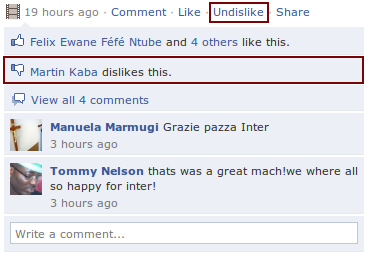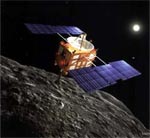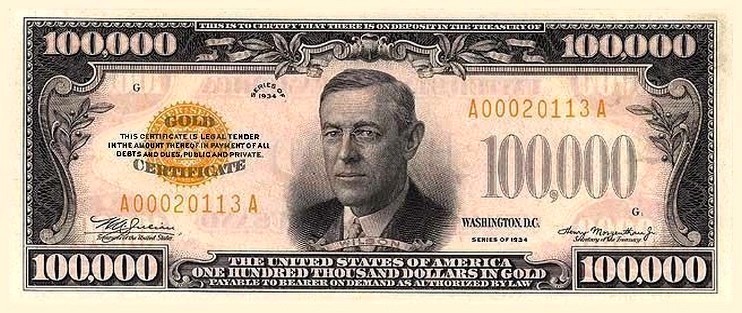 Oh, to have a "dislike" button on Facebook, to be able to tell your friends what you really think of their movie reviews or their complaints about the job when you know you work much harder than they do.
Oh, to have a "dislike" button on Facebook, to be able to tell your friends what you really think of their movie reviews or their complaints about the job when you know you work much harder than they do.
There is such a button being offered around on Facebook, but it is not the real thing. Not only is it not the real thing — it's a rogue application, and if you give it permission to access your profile, it will post spam messages from your account. It will ask you to complete an online survey, which generates money for the wisenheimers who dreamed this scam up.
You may see postings on your Facebook wall purportedly from your friends who may have bitten on this one. And who can blame them? The social networking site lets users click on a "like"  button with a "thumbs up" icon, or post comments about comments, but still, to date, there is no one-click way to transmit the sentiment: "No, I don't like this!"
button with a "thumbs up" icon, or post comments about comments, but still, to date, there is no one-click way to transmit the sentiment: "No, I don't like this!"
Graham Cluley, a senior technology consultant with software security firm Sophos, based in Britain, sounded the alert on his company's blog, noting that "it's the latest survey scam spreading virally across Facebook, using the tried-and-tested formula used in the past by other viral scams." Past successful scams include such lures as Justin Bieber flirting, the world's biggest and scariest snake and the "world's worst McDonald's customer."
 You might see messages posted on your wall saying, "Get the official DISLIKE button NOW!" or "I just got the Dislike button, so now I can dislike all of your dumb posts lol!!." Ignore, ignore, ignore and do not give the application permission to run, says Cluley.
You might see messages posted on your wall saying, "Get the official DISLIKE button NOW!" or "I just got the Dislike button, so now I can dislike all of your dumb posts lol!!." Ignore, ignore, ignore and do not give the application permission to run, says Cluley.
"If you do give the app permission to run, it silently updates your Facebook status to promote the link that tricked you in the first place, thus spreading the message virally to your Facebook friends and online contacts," he wrote.
 "But you still haven't at this point been given a 'Dislike' Facebook button, and the rogue application requires you to complete an online survey." The survey will help make money for the scammers, and point you to a Firefox browser add-on for a "Dislike" button made by FaceMod as a Facebook add-on.
"But you still haven't at this point been given a 'Dislike' Facebook button, and the rogue application requires you to complete an online survey." The survey will help make money for the scammers, and point you to a Firefox browser add-on for a "Dislike" button made by FaceMod as a Facebook add-on.
FaceMod, Cluley says, is not connected with the scam — "their browser add-on is simply being used as bait." Cluley says that if you are desperate to try the actual Dislike button (which his firm is in no way endorsing), be sure to get it only through the Firefox Add-ons Web page.
Part of the reason an offer for a "dislike" button is so alluring is because some Facebook users want one. More than 3 million of them have joined a group on Facebook to say so.
In a July interview with ABC, Facebook CEO Mark Zuckerberg said company officials would "definitely think about" adding a "Dislike" button. But like it or "dislike" it, it hasn't happened yet.
The boy suffered a minor burn and was taken to James Paget Hospital, where he is expected to make a full recovery.
Jason Gillingham, county ambulance officer and on scene at the show, said: ''This was a very minor burn to the boy's shoulder, but he was conveyed to hospital and is recovering well."
A second teenager and a woman were also struck by lightning but did not need hospital treatment.
The three were watching a display of the Red Arrows during a downpour when the lightning struck.


 The world’s largest tidal turbine was recently unveiled on August 11th 2010 at Invergordon, Scotland, weighing 130 tons, 74ft (22.6m) tall, with two 60ft (18.3m) diameter rotors and generating 1MW on both tidal ebb and flow. The Atlantis Resources AK1000 can supply power to 1000 homes, and is to be installed at the European Marine Energy Centre in the Orkney Islands, and has taken more than ten years to develop.
The world’s largest tidal turbine was recently unveiled on August 11th 2010 at Invergordon, Scotland, weighing 130 tons, 74ft (22.6m) tall, with two 60ft (18.3m) diameter rotors and generating 1MW on both tidal ebb and flow. The Atlantis Resources AK1000 can supply power to 1000 homes, and is to be installed at the European Marine Energy Centre in the Orkney Islands, and has taken more than ten years to develop.
Atlantis Resources' chief executive Tim Cornelius explained that, " The turbines turn at six to eight revolutions per minute, so are incredibly slow turning and will have zero impact on the surrounding environment." Theoretically, the turbine rotors should not harm marine animals.
So what is Tidal Current Power?
Tidal current technology is a form of hydropower and harnesses the energy in tides and converts it into usable power.
Tidal current power is different from wave power. Wave power harnesses power of the waves while Tidal Current technology extracts energy from the high tide bulge created by the gravitational pull of the Moon and Sun moving horizontally around the Earth’s surface.
As per the Atlantis, Sea water, which is 832 times denser than air, gives a 5 knot ocean current more kinetic energy than a 350 km/h wind; therefore ocean currents have a very high energy density. Hence a smaller device is required to harness tidal current energy than to harness wind energy.
Tidal Power and Tidal current power differ in that, Tidal power requires the building of barrages to manage and direct the flow of the current etc… the civil construction cost and impact on the environment is much higher in the tidal power barrage systems.
Tidal Power facts:
- The first large scale tidal power system the Rance Tidal Power station in Brittany, France, started functioning in 1966! It is still the largest tidal power station based on installed capacity.
- Tidal power stations were first developed and tested in the 1970’s; they harness the water masses that periodically flow into sea bays and drive conventional hydro turbines when the tide goes out. The disadvantage of this technology is that they require large barrages in the sea.
- Unless taken to extremes, Tidal Current power system does not require blocking of any waterways, and hence does not have the adverse environmental effects associated with Tidal Barrages.
- Tidal current energy takes the kinetic energy available in currents and converts it into renewable electricity.
- As oceans cover over 70% of Earth’s surface, ocean energy (including wave power, tidal current power and ocean thermal energy conversion) represents a vast source of energy, estimated at between 2,000 and 4,000 TWh per year, enough energy to continuously light between 2 and 4 billion 11W low-energy light bulbs.
- USA and UK could produce 15% of power they need from the Ocean itself.
On the whole the project sounds and looks really good and it has been working in Australia. Will wait to see how it works out in Orkney, Scotland.
 Thousands of people flocked to an exhibition in Japan on Sunday to see a capsule from the Hayabusa space probe which was hoped to have brought asteroid dust to Earth.
Thousands of people flocked to an exhibition in Japan on Sunday to see a capsule from the Hayabusa space probe which was hoped to have brought asteroid dust to Earth.  Some 1,800 people were queuing in Tokyo to see the heat-proof pod, which had travelled in space with the unmanned craft for seven years, even before the exhibition opened in the morning, a Japan Aerospace Exploration Agency (JAXA) spokesman said.
Some 1,800 people were queuing in Tokyo to see the heat-proof pod, which had travelled in space with the unmanned craft for seven years, even before the exhibition opened in the morning, a Japan Aerospace Exploration Agency (JAXA) spokesman said.
 More than 7,000 had visited the first public showing of the capsule by early evening, he said, adding that the space agency expects as many as 50,000 people during the five-day exhibition.
More than 7,000 had visited the first public showing of the capsule by early evening, he said, adding that the space agency expects as many as 50,000 people during the five-day exhibition.
The capsule, which journeyed billions of kilometres (miles), was fired back to Earth in June.
Technical problems had plagued the Hayabusa, which at one stage spun out of control and lost contact with JAXA for seven weeks, delaying the mission for three years until the asteroid and Earth re-aligned.
When it finally latched onto the potato-shaped Itokawa asteroid, a pellet-firing system designed to stir up dust malfunctioned, leaving it unclear how much material the probe was able to gather.
 Scientists hope any dust samples from the ancient asteroid in the capsule could help reveal secrets about the origins of the solar system.
Scientists hope any dust samples from the ancient asteroid in the capsule could help reveal secrets about the origins of the solar system.
The space agency has said it found "minute particles" of what it hopes is asteroid dust in the capsule, but it is expected to take months to get the final results of the analysis.
The Hayabusa project has generated great excitement in Japan.
"I was so impressed that such a small thing came back to Japan after a seven-year space journey," said one of the visitors. "It is just amazing."
 In an economic downturn, it might be tough to get your head around this: rare sheets of $100,000 bills, fabulous gold treasures dating back to the California Gold Rush era, rare coins including those tied to the first stirrings for America's independence and federal government securities worth more than a billion dollars.
In an economic downturn, it might be tough to get your head around this: rare sheets of $100,000 bills, fabulous gold treasures dating back to the California Gold Rush era, rare coins including those tied to the first stirrings for America's independence and federal government securities worth more than a billion dollars. That's the backdrop of the country's premier money show, the World's Fair of Money, which has brought about 1,000 coin dealers and hundreds of collectors to Boston, seeking to tap into the surprising resilience of the coin industry.
Held in a sprawling hall monitored by armed uniformed and undercover police officers, federal agents, private security contractors, electronic surveillance equipment and vigilant participants, the fair features seldom-seen gold treasurers brought from the Smithsonian Institution's vaults including America's first $20 gold coin — valued by independent experts at $15 million today — and its last $20 coin.
 It also includes sheets of America's largest denomination currency, the $100,000 bill, which is said to be worth about $1.6 million today. The gold certificate note, which bears President Woodrow Wilson's portrait, was used only for official transactions between Federal Reserve Banks. It was not circulated among the general public and cannot be legally held by currency note collectors.
It also includes sheets of America's largest denomination currency, the $100,000 bill, which is said to be worth about $1.6 million today. The gold certificate note, which bears President Woodrow Wilson's portrait, was used only for official transactions between Federal Reserve Banks. It was not circulated among the general public and cannot be legally held by currency note collectors.
"The reaction from kids to grandparents is universally the same: `Wow, that's a lot of money.' So, they wouldn't mind having it," Kevin Brown, manager in the marketing division of the U.S. Treasury Department's Bureau of Engraving and Printing, said while holding the $100,000 bills. "People like to see money."
There even was some free money at the show after the Bureau of Engraving and Printing handed out $150 bills to some children as souvenirs — thoroughly shredded and packed into tiny plastic bags.
The show, which ends Saturday, includes a comprehensive collection of U.S. paper money that has never before been exhibited. It has coins from the Mexican War of Independence and Mexican Revolution that are being seen outside of Mexico for the first time since 1970. There also are rare coins worth several million dollars.
The SS Central America, which sank in a 1857 hurricane off the coast of North Carolina with more than 400 passengers and 30,000 pounds of gold from the California Gold Rush, made its inaugural appearance in Boston. The exhibit features more than $10 million in gold treasure recovered from the ship, also known as The Ship of Gold.
Other historic items include one of the few known surviving copies of the Declaration of Independence printed in Boston circa July 17, 1776, and silver spoons crafted by Paul Revere.
 "It's overwhelming. I mean, I have been to a couple of these other conventions and I've never seen this much, this many high-level items as you're seeing here. Just the exhibits they've got in this whole museum area, incredible," Jim Moorey of Northbridge, Mass., said while visiting the show with his 13-year-old son, Tyler.
"It's overwhelming. I mean, I have been to a couple of these other conventions and I've never seen this much, this many high-level items as you're seeing here. Just the exhibits they've got in this whole museum area, incredible," Jim Moorey of Northbridge, Mass., said while visiting the show with his 13-year-old son, Tyler.
More than 3,400 coins, paper money, medals, tokens and other numismatic items were being auctioned at the event, including a New England shilling struck in 1652, as sentiment for America's independence grew.
Greg Rohan, president of Dallas-based Heritage Auction Galleries, said his company expects to raise $40 million dollars at its auction at the money fair. During the five-day show, more than $100 million will trade hands, he said.
"It's people who've decided they'd rather have the round, metal coins that we sell than $40 million in cash that they have in the bank," Rohan said.
There are an estimated 200,000 serious coin collectors in the United States and more than a million casual collectors who spend about $3 billion annually, he said.
 "The economic conditions have not diminished the demand for material from the standpoint of collectors who seek and desire to own the rare and exquisite pieces," said Larry Shepherd, president of the Colorado Springs, Colo.-based American Numismatic Association.
"The economic conditions have not diminished the demand for material from the standpoint of collectors who seek and desire to own the rare and exquisite pieces," said Larry Shepherd, president of the Colorado Springs, Colo.-based American Numismatic Association.
Demand also has been fed by rich people who are increasingly willing to store some of their wealth in rare coins with a proven history of gaining value after traditional investments vehicles, including real estate and the stock and bond markets, dipped to woeful levels during the economic crisis, Shepherd said.
"The very best coins, the very rarest coins, are worth as much today, if not more, than they were before September 2008," Rohan said. "So if you had bought rare coins prior to 2008, you've got the same value, if not more, today."
The rest of the coins have seen their fortunes range from gains of 10 percent to losses of up to 25 percent.
Still, that did not stop Brian Hendelson of Bridgewater, N.J.-based Classic Coin Company from offering to pay about $100,000 for a gold ingot salvaged from SS Central America.
"I'm 51, I've been doing this since I was 10 — collecting at 10 and trading coins at 14, 15 ... it beats pushing a broom," Hendelson said.
 (Reuters) – A lake in Argentina's remote, inhospitable northwest may offer clues on how life got started on Earth and how it could survive on other planets, scientists say.
(Reuters) – A lake in Argentina's remote, inhospitable northwest may offer clues on how life got started on Earth and how it could survive on other planets, scientists say. Researchers have found millions of "super" bacteria thriving inside the oxygen-starved Lake Diamante, in the center of a giant volcanic crater located over 15,400 feet above sea level.
The bacteria's habitat is similar to primitive earth, before living and breathing organisms began wrapping a protective atmosphere of oxygen around the planet.
The conditions -- which include high arsenic and alkaline levels -- could also shed light on life beyond Earth.
 "This is of great scientific interest as a window to look to our past and also for a science called astrobiology, the study of life on other planets," said Maria Eugenia Farias, part of the team that discovered the life-forms in Lake Diamante earlier this year.
"This is of great scientific interest as a window to look to our past and also for a science called astrobiology, the study of life on other planets," said Maria Eugenia Farias, part of the team that discovered the life-forms in Lake Diamante earlier this year.
If bacteria can survive here, the theory goes, it could also survive somewhere like Mars.
So-called "extremophiles" have been found in other parts of the world -- and they can have significant commercial value. Bacteria that break down lipids are used in detergents for example.
But Farias said these bacteria, called "polyextremophiles" are exceptional because they flourish in the harshest of circumstances.
"What we have here is a series of extreme conditions all in one place. And this is what makes this place unique in the world," said Farias, a microbiologist at the National Scientific and Technical Research Council in Tucuman province.
 The lake sports levels of arsenic 20,000 times higher than the level regarded as safe for drinking water and its temperature is often below freezing. But because the water is so salty -- five times saltier than sea water -- ice never forms.
The lake sports levels of arsenic 20,000 times higher than the level regarded as safe for drinking water and its temperature is often below freezing. But because the water is so salty -- five times saltier than sea water -- ice never forms.
The bacteria's DNA mutates to survive the ultra-violet radiation and low oxygen levels found at such high altitudes, which could make it of interest to the pharmaceuticals industry, Farias said. It could also have future commercial applications in products such as sunscreens, she added.
Farias and her team are looking for Argentine funding to produce a metagenome of the bacteria, an advanced study which provides a DNA sequence of the entire microbe colony.
This would enable her crew to study the bacteria in Argentina and help ensure that the South American country keeps hold of potentially lucrative patents for new antioxidants or enzymes that could be derived from the bacteria.
 Apple Inc. is getting exclusive access to an exotic metallic material that could provide it with shiny, super-tough computer and phone casings.
Apple Inc. is getting exclusive access to an exotic metallic material that could provide it with shiny, super-tough computer and phone casings.Liquidmetal Technologies Inc., a Caltech spinoff in Rancho Santa Margarita, Calif., filed a regulatory notice recently that it's granted Apple a perpetual, exclusive license to use its technology in consumer electronics. Liquidmetal retains the rights for other applications.
Apple isn't saying anything about the deal, and it's far from certain that the material will ever make it into its products. Though it matches the sleek Apple aesthetic, it's prohibitively expensive.
The name "Liquidmetal" brings to mind the silvery, shapeshifting villain of the "Terminator 2" movie, but the company's products are somewhat less dramatic. It mixes molten metal alloys in such a way that, when they cool, the structure of the material is more similar to glass than metal.
 The materials aren't translucent, but they have other interesting benefits.
The materials aren't translucent, but they have other interesting benefits.
One is that they can be cast so precisely that they need little or no machining afterward. Regular metals shrink as they cool, which means they lose contact with the die and need polishing for a smoothness.
"Metallic glass" can also be very hard. Hard materials are often brittle, like glass, and that was a problem with early alloys. Liquidmetal CEO Thomas Steipp said the company has figured out how to make tougher variants, much like Pyrex glass is tougher than regular glass.
Apple is big on using metal in its designs -- virtually every Mac is clad in aluminum, except for the cheapest MacBook. It's even started making the bodies for its laptops and Mac mini desktop computers out of single, big chunks of aluminum that it then hollows out. With Liquidmetal, that time-consuming process could conceivably be replaced with casting. Aluminum is also a relatively soft metal, prone to denting, scratching and scuffing.
 However, Liquidmetal is still very expensive because of it needs exotic raw materials, including beryllium. Some Liquidmetal alloys contain large amounts of platinum, which costs $1,500 an ounce. The alloys have gone into luxury watches, luxury phones, medical devices and some sporting gear, such as tennis rackets and skis, but they are far from being mass-market materials.
However, Liquidmetal is still very expensive because of it needs exotic raw materials, including beryllium. Some Liquidmetal alloys contain large amounts of platinum, which costs $1,500 an ounce. The alloys have gone into luxury watches, luxury phones, medical devices and some sporting gear, such as tennis rackets and skis, but they are far from being mass-market materials.
Steipp said he could not say what Apple might use the materials for. Neither company disclosed the value of the deal, but Liquidmetal seems to have gotten a shot in the arm from it. It hasn't filed a financial statement since last year, but Steipp, an experienced technology executive, was appointed five days after the deal was announced.
"I believe there's an opportunity for Liquidmetal to be a catalyst for changing the way that product designers think about building their products. It's that different," Steipp said. "We have to prove that, but certainly from what I've seen as technology executive evaluating the technology before I came in ... we've made a lot of progress over the last eight years."
 They're fast, they're bright and they'll put on a free show in the nighttime sky in the next couple of days for Nevadans willing to give up an hour or two of sleep.
They're fast, they're bright and they'll put on a free show in the nighttime sky in the next couple of days for Nevadans willing to give up an hour or two of sleep.  The number of meteors have been increasing for the last couple of weeks and will peak Thursday and Friday, usually with more than 60 meteors per hour and sometimes up to 100, he said.
The number of meteors have been increasing for the last couple of weeks and will peak Thursday and Friday, usually with more than 60 meteors per hour and sometimes up to 100, he said.
"This year is going to be good because there's a new moon, so on Thursday, there will be just a thin crescent moon, and it will set shortly after sunset," Berendsen said. "That means all night, we will have dark skies, and the weather is supposed to be clear, which should make it real nice for viewing."
Meteors are pieces of comets, which are dirty snowballs in space made up of frozen ice and rock-like particles, Berendsen said. The particles that become the meteors in the Perseid showers come from the Swift/Tuttle comet discovered in the 1860s.
"Most of the meteors are about the size of a grain of sand or a thumb, but they are traveling 20,000 mph and there is enough atmosphere up there that they run into atoms and molecules," he said. "So, even if they're just the size of a grain of sand, they give off a fair amount of light when they vaporize."






